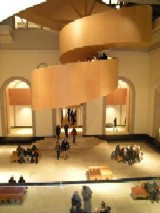 |
|
Special
Sessions on Mathematics Education |
|
Bringing
Reality into the Classroom
|
Time:
Saturday, June 23, 2012, 8:45AM - 3PM
Location: Fields Institute, 222 College (map
to venue)
Organizers:
Jane Heffernan, Dragana Martinovic, Walter Whiteley, Hongmei Zhu
Modern
technology offers ample opportunities to help students at all
levels to make meaningful connection between the real world and
the abstract mathematical world. This theme focuses on providing
practical applications of mathematics to enhance mathematics teaching
and learning in classroom. Some examples in particular with regard
to fractals, digital image processing, modeling and simulations,
modeling contests, hands-on activities for secondary and post
secondary students are discussed.
Schedule
| 8:45
a.m. |
Opening Remarks |
| 9:00
am |
Herb
Kunze, University of Guelph,
Using the mathematics of fractals to work (and play) with
images |
| 10:15
a.m. |
Coffee
Break (refreshments provided) |
| 10:30
am |
Varvara
Nika (York University) and Francis Libermann (Catholic
High School)
Geometer Sketchpad Will Change Your Classroom: From Traditional
Paper-and-Pencil to Dynamic Learning Environment. |
| 11:00
a.m. |
Guangchong
Zhu (Lawrence Technological University): Making Abstract
Math Real. |
| 11:30
|
Lunch
(your own arrangements)
Poster Presentations and Computer Demos on “iMath: Think
Math in Pictures”
“Fun-ctional
Foto-graphs: An Exploration Using GIMP” by Velisa Anusic,
Grazia Barone, Patrick McQuade, Ramnik Sharda
“Using Medical Imaging Processing to Teach College
Finite Mathematics” by Katie Arkadyev, Karen Kong,
Melanie Christian
“Digital Images and Matrices” by Catherine Madukayil,
Darshana Patel, Rebeka Pali
|
| 12:30
pm |
Jane
Heffernan, York University,
Mathematical Modeling
and Simulations: Part I |
| 1:15
pm |
Coffee
Break (refreshments provided) |
| 1:30
pm |
Jane
Heffernan, York University
Mathematical Modeling and Simulations: Part II |
| 2:15
pm |
Jane
Heffernan (York University),
Dragana Martinovic (University of Windsor),
Walter Whiteley (York University),
Mathematical Contests in Modeling |
Abstracts
for the Oral Presentations:
Using
the Mathematics of Fractals to Work (and Play) with Images
Speaker: Herb Kunze, University of Guelph
In
recent years, I have run sessions on campus and made high school
visits to work interactively with students on the mathematics
of certain kinds of fractals. Through worksheets, discussions,
and computer demonstrations, the students can understand the main
mathematical ideas. It works well for several reasons: the ideas
are presented in an accessible way, there are pictures, there
is a "puzzle" nature to things like the "fractal
dimension," we end up working on applications with real images
(a photo of the class), and (as they write in feedback) I think
they find the whole thing fun. I would like to share with you
the topics that the students, their teachers, and I work through,
as well as the worksheets and computer demonstrations/programs
that have evolved over time. My goal is to convey to you the fun,
wondrous, and accessible nature of the material.
Geometer
Sketchpad Will Change Your Classroom: From Traditional Paper-and-Pencil
to Dynamic Learning Environment
Speaker: Varvara Nika, York University & Francis Libermann
Catholic High School
Multiple
representations of concepts enhance student’s learning and
understanding and increase student’s engagement. In
this workshop we will explore how the use of GSP in the math classroom,
enables students to explore and learn on their own the meaning
of several concepts that seem much more difficult than they really
are, and to take their learning into their own hands. The participant
will have a chance to observe, see, and maybe even practice some
GSP applications. Fractals and their applications in the
world around us, iterative sequences, Fibonacci sequences, Rene
Descartes Curve Sketching Devices, etc, will be such examples.
We will also be discussing some time-saving techniques
with GSP such as: iterations, animations etc.
Making
Abstract Math Real
Speaker: Guangchong Zhu, Lawrence Technological University
Many
students struggle with math because of its abstractness.
As a result, they rely on mechanical memorization rather than
conceptual understanding to learn math. In this talk, we
illustrate some creative ideas on how to make abstract math intuitive,
vivid, and real.
Mathematical
Modeling and Simulations: Part I and Part II
Speaker: Jane Heffernan, York University
Mathematical
models are used to investigate and make predictions about real
world phenomenon. Mathematical models have advanced knowledge
in many fields (i.e. biology, chemistry, geography, epidemiology,
immunology, etc) and have aided in the development of new tools
used to simplify and optimize social,
industrial and health processes. In this session we will review
the modelling
process and discuss some advancements due to modelling in biology,
medicine and public health.
Mathematical
Contests in Modeling
Speakers: Jane Heffernan, York University
Dragana Martinovic, University of Windsor
Walter Whiteley, York University
Mathematics
contests engage students in mathematical reasoning and problem
solving. They can be used to measure performance and mathematical
ability of
individuals or teams, and can also be used to provide opportunities
for students or teams to apply mathematical tools and concepts
to real world problems. This session will include an overview
of some high school mathematics and mathematical modelling contests,
and a discussion on the benefits of providing these contests in
the high school setting.
Abstracts
for Poster Presentations and Computer Demos:
Fun-ctional
Foto-graphs: An Exploration Using GIMP
Presenters:
Velisa Anusic, Castlebrooke Secondary School, Peel DSB
Grazia Barone, Marshall McLuhan Catholic Secondary School,
Toronto CDSB
Patrick McQuade, HJA Brown Education Centre, Peel DSB
Ramnik Sharda, Chinguacousy Secondary School, Peel DSB
Within
the grade 11 Functions course, MCR3U, the use of computer technologies
ensure that concepts of variable and function can become rich
explorations where finding solutions to satisfy equations becomes
the outcome of a student’s understanding of material rather
than the ultimate goal.
Digital image processing provides a dynamic exploration of the
relationship established by functions, including the roles of
variables, domain and range. In this manner functions are no longer
abstract objects that students test against vertical lines, instead,
functions become meaningful representations that influence real-world
occurrences.
To this end, we have created a consolidation activity which will
lead students through an investigation exploring how the concepts
of function, domain, range and inverse apply to digital imaging.
Using
Medical Imaging Processing to Teach College Finite Mathematics
Presenters:
Katie Arkadyev, Stephen Lewis Secondary School, York RDSB
Karen Kong, York University
Melanie Christian, St. Lawrence College
Our
mini unit is a four-lesson sequence designed to introduce college-level
students to basic matrix operations through image processing.
The unit is part of the Math 19, Finite Mathematics Course, offered
by St. Lawrence College in Kingston. Math 19 is selected by students
interested in medical and business fields. Community college learners
demand practical up-to-date learning experiences. Medical image
processing offers an authentic application of basic matrix theory.
Lessons in the unit include: Introduction to MATLAB, Types of
Medical Imaging (X-Ray, CAT-Scan, MRI, and ultrasound), Matrix
Subtraction and Addition of Medical Images, and Improving Visibility
of Medical Images Using Logarithmic and Contrast Transforms. Several
classroom- ready activities and games are included such as spot-the-difference
and a hospital walkthrough activity. Ethical issues of misdiagnosis
are also discussed.
Digital
Images and Matrices
Presenters:
Catherine Madukayil, Sheridan College
Darshana Patel, Centennial College
Rebeka Pali, York University
This
lesson plan is designed for college students. It aims at introducing
to students an interesting application of the matrices in representing
the digital images. Taking into consideration a certain level
of difficulty shown by students in operating with matrices,
the goal of this lesson plan is inviting students to make simple
arithmetic operations with digital images, as an ‘easy to
be memorized method’ of doing the same operations with
matrices. This will help students for a better visualization of
the results via fun activities in digital image processing.
some of the activities include: representing of digital images
by matrices, adding and subtracting matrices, finding
the inverse of a given matrix, finding the transposed of
a matrix and understand how this transformation operates to the
digital images, as well as representing the linear combination
of matrices in terms of digital images.
|
|






